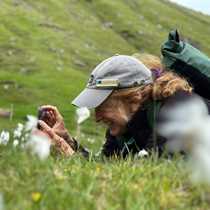Los Islotes, Isla Espiritu Santo & Bahia Bonanza
Before the sun could rise over the eastern horizon we had common dolphins leaping and swimming towards us, apparently eager to ride the bow wave of the National Geographic Sea Bird. As the sun lifted above the low clouds, the morning light began to sparkle and dance upon the sleek bodies of the dolphins. Bursting from the horizon as an illuminated geyser, a blow from a whale on the horizon snatched our attentions. As the back of the animal rolled in the progression of a dive, we waited patiently for the dorsal fin to show, and finally a tiny pointed bump of a dorsal fin came into view and the dive ended in broad flukes lifted skyward. A blue whale with a flukes up dive. Nice, exceptionally nice.
Our visit to Los Islotes was introduced by a barking chorus of California sea lions. Draped and drowsy bodies were stacked in reclining piles and nestled on the rocks. These animals made this guano crusted islet laced with a jagged barnacle necklace seem as comfortable and inviting as a feather bed. As we cruised around the islet in our Zodiacs, pinniped popcorn erupted all around us. Juvenile sea lions displayed the exuberance of youth as they chased, raced, cavorted and zoomed through the water.
In route to our afternoon anchorage at Bahia Bonanza, we stopped to gather data for a project Lindblad Expeditions is facilitating with National Geographic. Stanford Professor Dr. William Gilly is working on a project which involves gathering readings of oxygen levels, salinity, chlorophyll and temperature against time and depth. This involves dropping a specialized instrument to water depths of approximately 1,500 feet. Our guests observed as our ships officers deployed the probe and our Captain explained the mechanics of deployment and successful retrieval of the probe and the subsequent data it gathers.
For the late afternoon, the open arms of Bahia Bonanza took us into its warm sandy bosom for a delightful afternoon of snorkeling, kayaking and walks amongst the tenacious desert vegetation. Highlights included sightings of verdin, loggerhead shrike, Gila woodpecker and the black jack rabbit. Dark as a black bean with twice the power, we flushed this endemic denizen from its shady refuge and it bounded through and into the thick vegetation and once again, out of sight.
From gray whales to humpbacks to blues and two different dolphins. From egrets to osprey to stately cardon and vicious cholla cactus. Our experiences and memories of Baja California are diverse treasures we will share and cherish for years to come.
Before the sun could rise over the eastern horizon we had common dolphins leaping and swimming towards us, apparently eager to ride the bow wave of the National Geographic Sea Bird. As the sun lifted above the low clouds, the morning light began to sparkle and dance upon the sleek bodies of the dolphins. Bursting from the horizon as an illuminated geyser, a blow from a whale on the horizon snatched our attentions. As the back of the animal rolled in the progression of a dive, we waited patiently for the dorsal fin to show, and finally a tiny pointed bump of a dorsal fin came into view and the dive ended in broad flukes lifted skyward. A blue whale with a flukes up dive. Nice, exceptionally nice.
Our visit to Los Islotes was introduced by a barking chorus of California sea lions. Draped and drowsy bodies were stacked in reclining piles and nestled on the rocks. These animals made this guano crusted islet laced with a jagged barnacle necklace seem as comfortable and inviting as a feather bed. As we cruised around the islet in our Zodiacs, pinniped popcorn erupted all around us. Juvenile sea lions displayed the exuberance of youth as they chased, raced, cavorted and zoomed through the water.
In route to our afternoon anchorage at Bahia Bonanza, we stopped to gather data for a project Lindblad Expeditions is facilitating with National Geographic. Stanford Professor Dr. William Gilly is working on a project which involves gathering readings of oxygen levels, salinity, chlorophyll and temperature against time and depth. This involves dropping a specialized instrument to water depths of approximately 1,500 feet. Our guests observed as our ships officers deployed the probe and our Captain explained the mechanics of deployment and successful retrieval of the probe and the subsequent data it gathers.
For the late afternoon, the open arms of Bahia Bonanza took us into its warm sandy bosom for a delightful afternoon of snorkeling, kayaking and walks amongst the tenacious desert vegetation. Highlights included sightings of verdin, loggerhead shrike, Gila woodpecker and the black jack rabbit. Dark as a black bean with twice the power, we flushed this endemic denizen from its shady refuge and it bounded through and into the thick vegetation and once again, out of sight.
From gray whales to humpbacks to blues and two different dolphins. From egrets to osprey to stately cardon and vicious cholla cactus. Our experiences and memories of Baja California are diverse treasures we will share and cherish for years to come.



